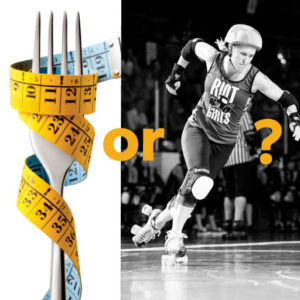
About a million years ago, Booty asked me what the biggest mistake people make when changing their diet to fuel for derby. The unequivocal answer is that they start eating for weight loss instead of eating for performance.
There are SO many diets out there, mostly directed at weight loss, and it’s super easy to get overwhelmed. But a healthy nutrition strategy doesn’t need to be complicated.
If you’re starting from not-so-great dietary habits, don’t even worry about eating for performance just yet. Focus on eating veggies and lean protein with every meal or snack, and work on listening to your body’s hunger cues. Too many of us ignore these cues and just eat base on habit. Try to challenge yourself to form new habits.
If you’ve already got the above under control, it’s time to dig into the difference between fuelling your activities, versus eating to lose weight.
Don’t get me wrong, you can do both (and many derby athletes do), but your approach to food changes from a “10 pounds in 10 weeks” approach to a “here are some healthy strategies to use forever” approach.
Eating to Perform
Your ideal volume of various nutrients per day will be determined by your daily activities. As long as you’re eating high-quality, whole foods, you can easily adjust the amount you’re eating to suit your needs. While it would totally be easier for there to be an “exact right number of calories to eat” and an “exact right way to eat them”, the truth is that life doesn’t work that way. There will be days where you need more, days where you need less, days when you’re sick, days when you’re rehabbing an injury, days when you’re at a tournament. To eat well, you need to know the basics of portioning to help you adapt to those changing conditions.
A simple portioning tool is right at the end of your arm – your hand!
Protein
You can gauge your protein serving by the size of your palm. 1-2 palms per serving is a good rule of thumb.
Carbs
Carbs can be measured in your cupped hand. Again, 1-2 hands per serving. The more active you are, and the more muscle you carry, the more carbs you’ll need day to day. And we’re talking low-glycemic complex and simple carbs – fruits, veggies, whole grains and whole dairy products – limit your processed carbs!
Fat
Healthy fats get measured with your thumb, 1-2 thumbs per serving.
Fruits, Leafy Greens and Veggies
These get measured with your fist. A leafy green serving should be 2 fists worth, starchy veggies like potatoes and yams should be a half fist.
When you eat is important too! Ideally, aim to eat every 2-4 hours. Frequent eating helps to stimulate your metabolism, balance your blood sugar and helps you maintain lean mass while burning off fat mass. Eating more frequently will also help to keep you in touch with your hunger signals.
“But that seems like so much eating!”
5 meals per day is only a guideline. If weight loss is your goal, you may eat less frequently (3-4 times/day), if weight gain is your goal, you may need to eat more (up to 8 times/day). Each eating opportunity can be the same size, or some can be smaller and faster, some can be more elaborate. Whatever works for you!
Making a point of eating 1-2 hours before your training session and within an hour of your training session ending will do a whole host of good things for your body. It will:
- Replenish the muscle glycogen that you lose during activity
- Reduce muscle protein breakdown
- Increase muscle protein synthesis
- Reduce post-training soreness and fatigue, enhance recovery
- Reduce cortisol levels
When eating for performance, both the pre and post training meal should definitely contain both carbs and protein to give you the maximum benefit.
>> Want to get more guidance on all this? Check out the DerbyFuel program!
So what’s the difference between eating to perform and eating to lose weight?
If you want fat loss, you should keep your starchy carbs for your post-training meals. Why? Well, if you want to lose fat you need most of your carbs to come from fruits and vegetables, with a small amount of additional carbs coming from higher-sugar sources during training and higher-starch sources post-training. Your body will be most carb-tolerant and insulin sensitive after a workout, and will better process the carbs into energy.
If muscle gain is part of your goals, you definitely need carbs pre- and post- training, but you’ll also need more of them more of the time.
Remember, as an athlete, YOU NEED TO EAT. A LOT. Dieting to lose weight is often about self-denial. Eating to perform is about giving your body what it needs to do its job.
How do I track all of this?
I highly recommend using an app or journal to keep track of things, especially when you’re starting out and just getting a sense of how often and how much to eat. You want to start with your baseline of caloric intake for the day (geared to your level of activity and goals). For example, in the Derby Fuel meal plans, we start with a baseline of 1500-1750 calories per day (for women, 3000-3500 for men), and those numbers can go up (generally not down) depending on your energy needs and goals. Remember though, the quality of those calories is far more important than the quantity.
You can use the chart below to give you a rough idea of base intake:
|
Your Activity Level |
Lose Weight |
Maintain Weight |
Gain Weight |
|
Sedentary (minimal exercise) |
Bodyweight (lb) X 10-12 |
Bodyweight (lb) X 12-14 |
Bodyweight (lb) X 16-18 |
|
Moderately Active (exercise 3-4x/wk) |
Bodyweight (lb) X 12-14 |
Bodyweight (lb) X 14-16 |
Bodyweight (lb) X 18-20 |
|
Very Active (exercise 5-7x/wk) |
Bodyweight (lb) X 14-16 |
Bodyweight (lb) X 16-18 |
Bodyweight (lb) X 20-22 |
Next, you can follow the chart below to help tweak your individual nutrient breakdown needs by determining your general body type and evaluating your goals:
|
Body Type |
Characteristics |
Typical Goals |
% Protein |
% Carbs |
% Fat |
|
Ectomorph (naturally thin with thin limbs) |
Fast metabolic rate, higher carb tolerance |
Gain muscle strength and size, maintain body weight and strength during exercise |
Approx. 25% |
Approx. 55% |
Approx. 20% |
|
Mesomorph (naturally muscular and athletic) |
Moderate metabolic rate, moderate carb tolerance |
Build muscle mass while maintaining body fat percentage |
Approx. 30% |
Approx. 40% |
Approx. 30% |
|
Endomorph (naturally broad with thick limbs) |
Slow metabolic rate, low carb tolerance |
Lose body fat, especially in abdominal region |
Approx. 35% |
Approx. 25% |
Approx. 40% |
Plug the baseline calories and the macronutrient percentage breakdown into your app (I use myfitnesspal), and get tracking!
At the end of the day, eating for weight loss and eating for performance have the same foundations: eating whole, healthy foods, paying attention to when and what you’re eating. The difference is volume, timing, and more than anything – mindset.
So, what are you eating for?
Got questions or comments? Leave ’em below!
>> And if you want a simple plan to follow, that you can tailor to your goals, Check out DerbyFuel!
Happy fueling!
– Lilith NoFair

 Go From Benchwarmer to MVP with the 1% Secret
Go From Benchwarmer to MVP with the 1% Secret  Cross-Training for Roller Derby: A Primer
Cross-Training for Roller Derby: A Primer  How to Improve at Derby’s 27 Laps Test
How to Improve at Derby’s 27 Laps Test  Stop sucking. Start winning.
Stop sucking. Start winning.  The Top Ten Exercises for Roller Derby Athletes
The Top Ten Exercises for Roller Derby Athletes